What Do Gorillas Eat?
Gorillas are the largest of the great apes and one of the most intelligent animals in the world. There exist two extant species of gorilla, both of which are native to Sub-Sahara Africa. The more numerous species, the western gorilla, lives in the tropical forests of Cameroon, the Central African Republic, the Democratic Republic of Congo (DRC), Equatorial Guinea, Gabon, and the Republic of Congo. Meanwhile, the less numerous eastern gorilla lives in the mountains of Rwanda, Uganda, and DRC as well as the lowland forests of DRC. Due to habitat loss and poaching, the IUCN lists both species as Critically Endangered. Currently, conservationists from around the world work tirelessly to protect the remaining gorillas living in the wild and sanctuaries. Gorillas fascinate people with their human-like features and behaviors. That said, can you know the answer to the question “what do gorillas eat?”
If you’re curious to learn more about gorillas’ dietary habits, then you’re in the right place. Today, we’ll conduct a deep study of gorillas’ diets, paying special attention to what foods they eat. We’ll also explore how gorillas forage for food, and how their diet differs in the wild from in captivity. Finally, we’ll examine what baby gorillas eat, and see how their diet differs from an adult gorilla’s. So, come join us as we answer the question “what do gorillas eat.”
What Do Gorillas Like to Eat?
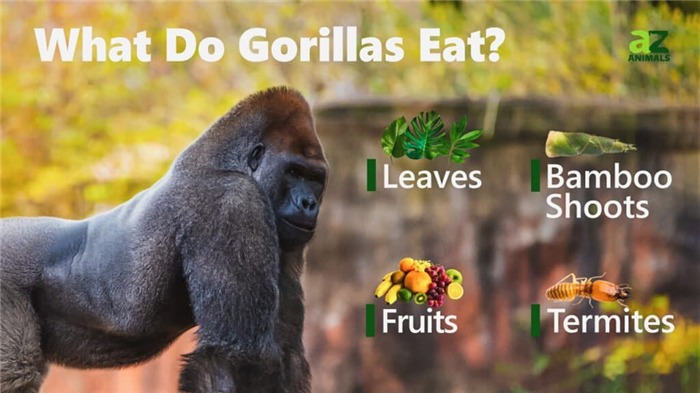
Gorillas eat leaves, bamboo shoots, fruits, and termites.
Despite their large, muscled physiques, gorillas are primarily herbivorous and eat mostly plant matter. Gorillas eat a wide variety of fruits and vegetable matter, all of which are locally available in the wild. That said, gorillas will also eat insects, which is where they get the majority of their protein requirement. Although legends exist of man-eating gorillas, these stories are mostly falsifications. Unlike chimpanzees, which will occasionally cannibalize other chimps or eat other animals, gorillas rarely engage in such behavior. While gorilla’s diet can vary depending on its range, there exist similarities in the diet of gorillas regardless of distribution. As such, we’ve identified 10 foods that most gorillas frequently consume. These foods include:
How Do Gorillas Forage For Food?
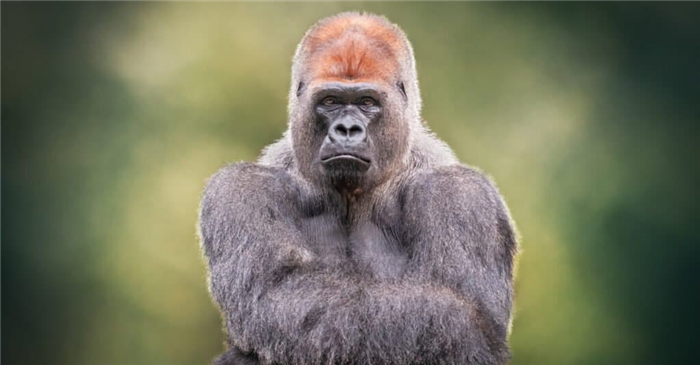
Gorillas rely on their sense of smell and sight to find and identify edible foods.
Gorillas have very similar senses to other apes and humans. They rely on sight, smell, taste, touch, and hearing to help them find food and survive in the wild. Sight and smell are arguably a gorilla’s most important senses when it comes to foraging for food. Their eyes enable them to see in color, which allows them to detect which plants are ripe. In addition, gorillas possess binocular vision, which allows them to accurately gauge distances and depth. Gorillas also adapted a finely attuned sense of smell, which they use to identify foreign or strange odors. Since most gorillas live in dense jungles, they often rely on hearing to help them detect threats. Rarely is hearing used to find food, as most of their diet is plant-based. Furthermore, gorillas rely on their deft hands when handling food, such as when tearing apart branches or stems.
The range of the average group of gorillas is between 1 and 6 square miles. That said, during the day, most gorillas travel no more than 1.5 miles in search of food. When not foraging, gorillas will rest before moving on to another area. Due to their smallish ranges, gorillas do not often compete with one another for food. When available, gorillas will also eat aquatic plants as well as terrestrial ones. Upon encountering a termite or ant colony, gorillas may break open the nest to eat the larvae. Gorillas possess strong jaws and teeth adapted for tearing and chewing leaves.
What Do Gorillas Eat in the Wild?
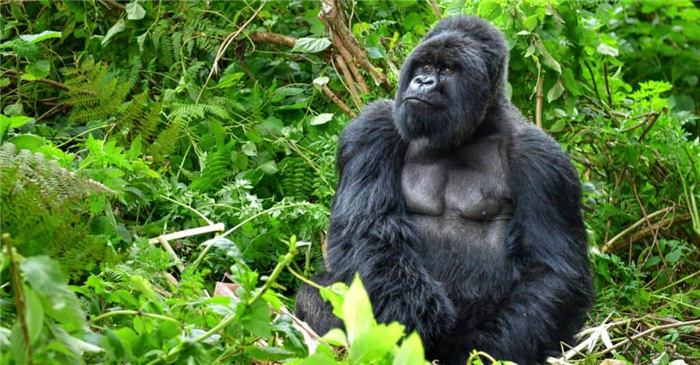
A gorilla relies on its strong jaw muscles to consume food such as nuts and tree bark.
The diet of a wild gorilla varies depending on the plants available in its home range. In addition, available foods will differ depending on the season, so a gorilla’s diet will change throughout the year. Western gorillas eat a diet that is high in fiber and mostly seasonal foods. Compared to eastern gorillas, fruit makes up a larger portion of a western gorilla’s diet. When fruits are in season, western gorillas will spend more time foraging for fruits. Meanwhile, in the dry season, they will eat more leaves, stems, and other low-quality vegetable matter. On the other hand, eastern gorillas predominantly eat foliage, as fruit is more scarce in their habitats. At most, fruit might make up 25% of an eastern gorilla’s diet.
In total, gorillas eat around 200 different types of plants. Their preferred foods include fruits such as berries, bananas, and guavas. Additionally, gorillas enjoy pith, which is a tissue made from the stems of certain flowering plants. That said, stems and leaves from high-quality plants make up the majority of most gorillas’ diets. Gorillas will often travel long distances to dine on the choicest leaves, shoots, and seeds. During leaner months, they will also eat roots, bark, stems, and other low-quality vegetation. When available, gorillas will also eat termites, ants, or grubs. Over the course of a day, it’s not uncommon for a gorilla to consume 20 to 40 different types of foods.
What Do Captive Gorillas Eat?
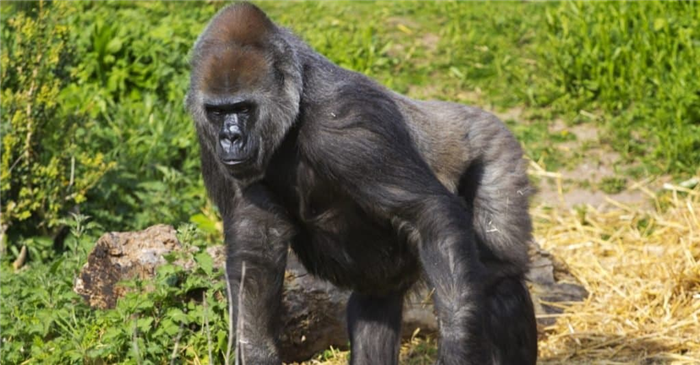
Gorillas eat a wide variety of foliage as well as some fruits.
Compared to wild gorillas, captive gorillas eat a diet that is more frugivorous than herbivorous. An adult gorilla is capable of eating up to 40 pounds of food in a single day. A captive gorilla may need to be fed up to six times a day. Fruits such as bananas, berries, guavas, and apples rank among the most common foods fed to captive gorillas. In addition, captive gorillas also have access to a wide variety of foliage. Some zoos will also provide gorillas with little treats such as processed cereals. That said, these treats are given only rarely, as they are not part of a gorilla’s natural diet. Due to the difficulty of maintaining ant and termite colonies, captive gorillas rarely have access to insects. However, grubs and larvae may be included as readily available protein sources.
What Do Baby Gorillas Eat?
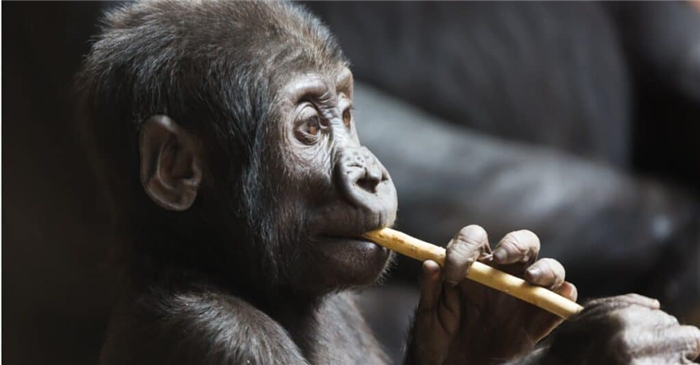
Baby gorillas subsist on their mother’s milk until they are old enough to eat the same diet as an adult gorilla.
At birth, newborn gorillas only weigh around 4.5 pounds but are still very strong. A baby gorilla can grip onto its mother’s body and will remain in close contact for several years. While young, baby gorillas subsist almost entirely on their mothers’ milk. On average, most gorillas will nurse for around 2.5 to 3 years, and which point they will wean off milk. At that point, they can begin to eat the same diet as an adult gorilla. That said, some infant gorillas will also eat some ants or insects, but only in small quantities.
Diet & Eating Habits
The composition of the gorilla’s diet varies by subspecies and seasonality.
- Western lowland gorilla (Gorilla gorilla gorilla): This subspecies consumes parts of at least 97 plant species. About 67% of their diet is fruit, 17% is leaves, seeds and stems and 3% is termites and caterpillars.
- Eastern lowland gorilla (Gorilla beringei graueri): This subspecies consumes parts of at least 104 plant species.
- Mountain gorilla (Gorilla beringei beringei): This subspecies consumes parts of at least 142 plant species and only 3 types of fruit (there is hardly any fruit available due to the high altitude). About 86% of their diet is leaves, shoots, and stems, 7% is roots, 3% is flowers, 2% is fruit, and 2% ants, snails, and grubs.
- Cross River gorilla (Gorilla gorilla diehli): This subspecies is not as well studied as the other subspecies. However their diet has been studied through their fecal matter and is known to include fruit, leaves, stems, piths, and some invertebrates.
- Gorillas are able to survive on vegetation such as leaves, stems, roots, vines, herbs, trees, and grasses but such vegetation has relatively low nutritional quality. Therefore, they must consume a larger quantity, but it is available year-round.
Food Intake
An adult male gorilla may consume more than 18 kg (40 lbs.) of vegetation per day.
Gorillas rarely drink in the wild because they consume succulent vegetation that is comprised of almost half water as well as morning dew.
Methods of Collecting Food
Gorillas can use their incredible strength to break apart vegetation. An adult male for example can shred apart a whole banana tree to get to the interior tender pith.
Gorillas are very selective foragers. They usually only eat parts of vegetation. For example they may eat only the leaves, pith, stalk, or roots of a particular plant. They use their agile lips and hand dexterity to manipulate the vegetation for the particular portion they want to consume.
Gorillas do not overexploit an area for food. They crop the vegetation in a manner that allows for quick replenishment to occur.
Gorillas have been documented using the hair on the back of their hands to absorb water and then sucking it.
What do gorillas eat?
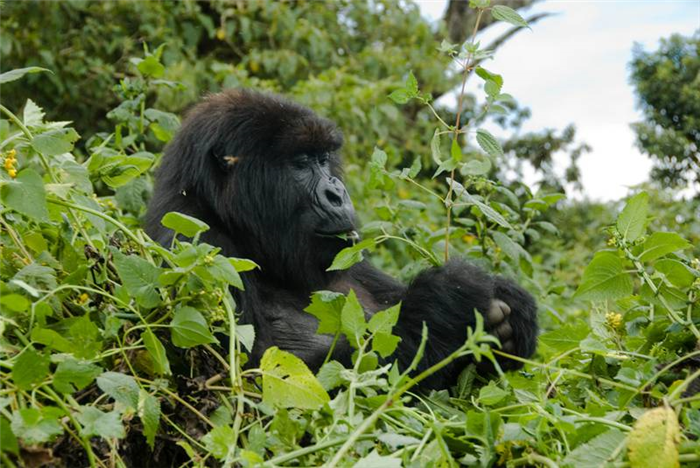
Feeding mountain gorilla (© Manfred Hartwig)
What gorillas eat depends on what their habitat provides and on the time of the year. Mountain gorillas mainly feed on green plant parts, whereas lowland gorillas eat a lot of fruit. However, in the dry season only a few juicy fruits are available and so the animals have to eat more seeds and tree bark instead. Usually, fruits grow on trees; gorillas of all ages climb these trees to harvest them. Although western gorillas eat a higher percentage of fruit than of leaves, stems, pith and shoots, they still eat markedly less fruit than do chimpanzees and orangutans.
The food range of the western gorillas is very broad: they eat about 200 plant species. They particularly like plants belonging to the ginger and arrowroot families. In contrast, the mountain gorillas in the Virunga Volcanoes eat only 38 different plant species, mainly Galium, thistles, celery and nettles.
An adult Grauer’s gorilla male is estimated to eat 30 kg of plants every day, an adult female about 18 kg. To be able to process these masses of plant material, gorillas have very strong chewing muscles. Their teeth are much like human teeth, except for the very long, pointed canines of adult gorilla males. The males do not use those for feeding but for fighting against competing males.
Apart from plants, they ingest soil occasionally. Perhaps this soil contains minerals that are missing in their plants, or the minerals neutralize poisonous substances in their food.
Although gorillas don’t kill big animals, they regularly eat small animals (mainly insects). However, this constitutes far less than 0.1% of their food. In chimpanzees, up to 6% of the food may be animal matter.
A study in Cameroon by Isra Deblauwe showed that gorillas have a high frequency of insect-eating and a high prey diversity, even higher than those for the sympatric chimpanzees. There are important differences in the nutritional composition of the gorilla and chimpanzee termite prey species. Gorillas select termites high in iron and ash with possible anti-diarrhoeal characteristics. Termite eating in western lowland gorillas might therefore be a high quality alternative for geophagy.
Gorillas eat different insect species in different regions; there may even be traditions in prey choice.
Gorilla guide: where they live, diet, and conservation
Our guide to one of our closest relatives – the gorilla, including the difference between the two species, why they’re endangered and conservation work.
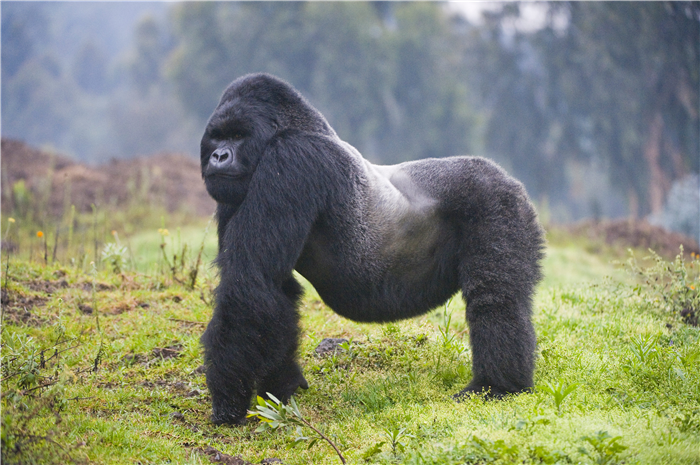
Learn all about our closest relatives – the gorillas, in our expert guide which explains why these intelligent mammals are endangered species and conservation work to protect them from extinction.
How many different species of gorilla are there?
There are two species of gorilla – the eastern gorilla (Gorilla beringei) and western gorilla (G. gorilla). Each of these is divided into two subspecies – eastern lowland gorilla (G. b. graueri) and mountain gorilla (G. b. beringei), and western lowland gorilla (G. g. gorilla) and cross river gorilla (G. g. diehli). We share 98.3% of our DNA with gorillas, making them our closest relatives after chimpanzees and bonobos.
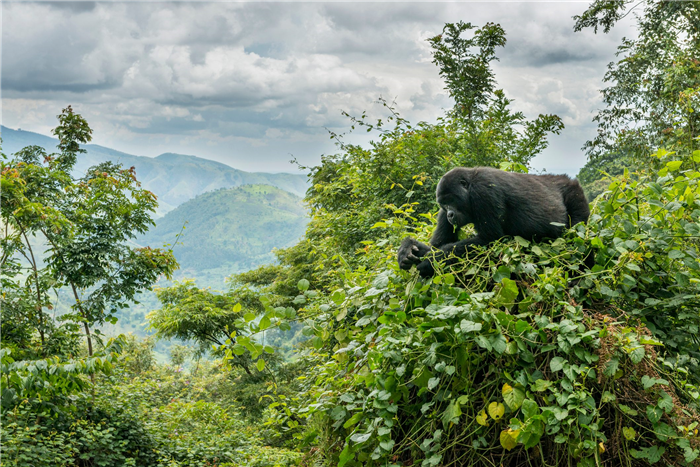
Mountain Gorilla (Gorilla beringei beringei) in its forest habitat, Bwindi Impenetrable National Park, Uganda. © Robert Haasmann/Getty
The two species live in central Africa, separated by a vast swathe of rainforest, and are both listed as Critically Endangered on the IUCN Red List.
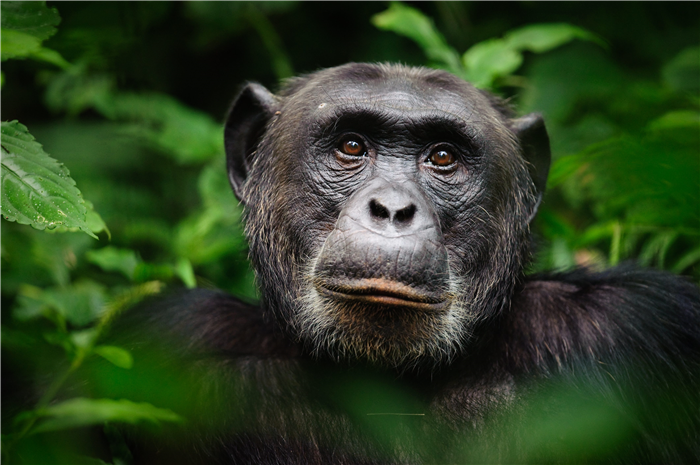
Why are gorillas endangered and how many gorillas are left?
The western lowland gorilla is the most numerous of the four subspecies, with population estimates often cited at 100,000-200,000. However, due to their dense, remote habitat, no one knows for sure how many exist. The least numerous is the cross river gorilla, which is confined to scattered areas of forest in Nigeria and Cameroon, and is thought to number no more than 300 individuals.
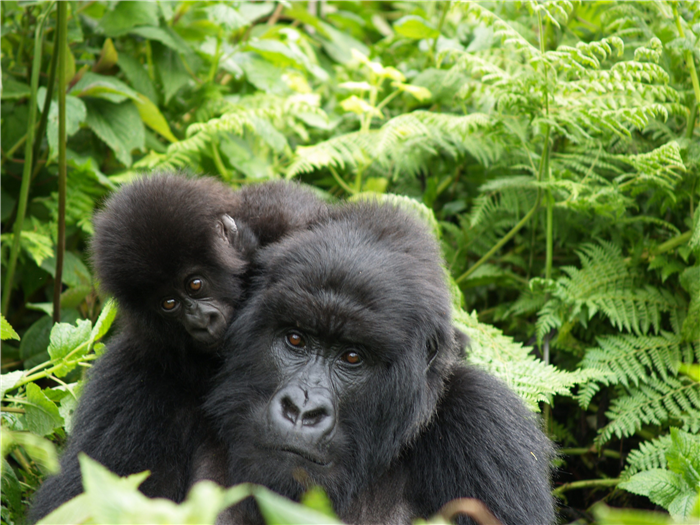
Recent surveys in the Virunga Massif estimate that the mountain gorilla population now stands at 1,004.
Sir David Attenborough, who first visited the mountain gorillas in 1979, said, “It is incredibly heartening to see how the efforts of so many different groups – communities, governments, NGOs – have paid off. The threats to mountain gorillas haven’t disappeared entirely, of course, so now the challenge must be to ensure that these achievements are sustained long into the future.”
Good news for mountain gorillas!
In November 2018, it was announced that mountain gorillas are no longer critically endangered, although conservation work continues.
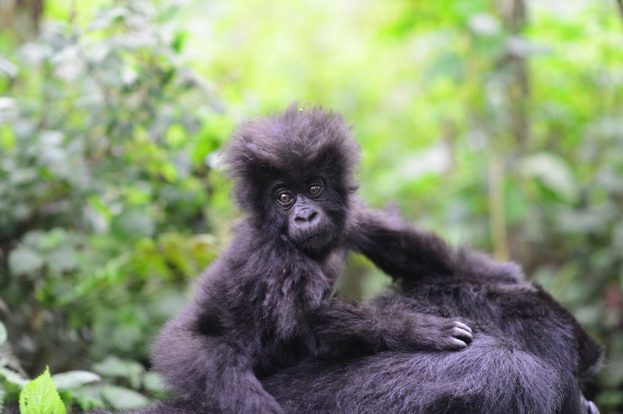
How much does a gorilla weigh?
Gorillas are the world’s largest primates, with males weighing around 143-169kg and standing about 1.4-1.8m tall in the wild. Females tend to be 20-30cm shorter and weigh roughly half what the males do. A male gorilla’s armspan is enormous, stretching 2.3-2.6m, while female gorilla’s armspans are proportionally smaller.
The world’s largest gorilla in the wild weighed 267kg when it was shot in Cameroon, but it wasn’t as tall as another silverback gorilla that was shot in Congo in 1938. That silverback stood 1.95m tall, measured 1.98m around the chest, had a 2.7m armspan and weighed an impressive 219kg.
In captivity, gorillas have reached even greater weights, sometimes in excess of 310kg.

How strong is a gorilla?
It’s hard to measure how strong a gorilla really is, but estimates range from around 4x – 10x stronger than your average human. A silverback gorilla’s strength is certainly formidable. All gorillas can tear down banana trees without trying too hard, they’ve escaped from cages by bending the iron bars, and they have a bite force of around 1300 psi, double that of a lion.
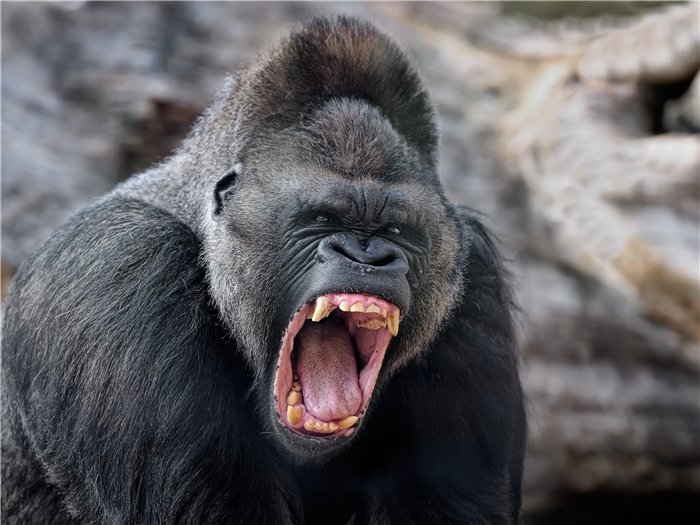
But apart from in conflicts between silverbacks, gorillas tend to be gentle giants that rarely display their full strength. They’re also built quite differently to humans, which makes them more efficient climbers and better adapted to walking on all fours. That means that measuring their strength by human standards doesn’t make a huge amount of sense, as they wouldn’t be able to perform some of the movements we take for granted because they balance completely differently.
Please note that external videos may contain ads:
How clever are gorillas?
Gorillas are highly intelligent. They don’t use tools as much as chimpanzees do, but wild gorillas have been seen using sticks to gauge water depth, bamboo as ladders to help infants climb, and recently gorillas have been seen for the first time using sticks to eat ants without being stung.
Another sign of intelligence is the gorilla’s impressive communication abilities, and they’ve been recorded making some 25 different sounds.
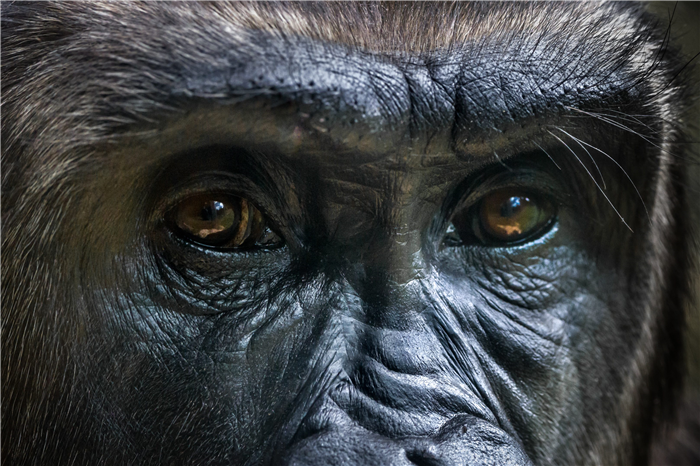
One famous captive-born individual, Koko, has been taught sign language since she was a year old. By the age of 40, she had a library of about 1,000 signs and could understand some 2,000 words of English.
How good is your primate knowledge?
What do gorillas eat?
Gorillas are mainly herbivores, and their diet mostly consists of bamboo, fruit and leafy plants, though western lowland gorillas also eat small insects. Adult gorillas can eat up to 30kg of food each day.
As roaming herbivores, gorillas play a vital role in seed dispersal. Many large fruit trees depend upon these animals to survive.
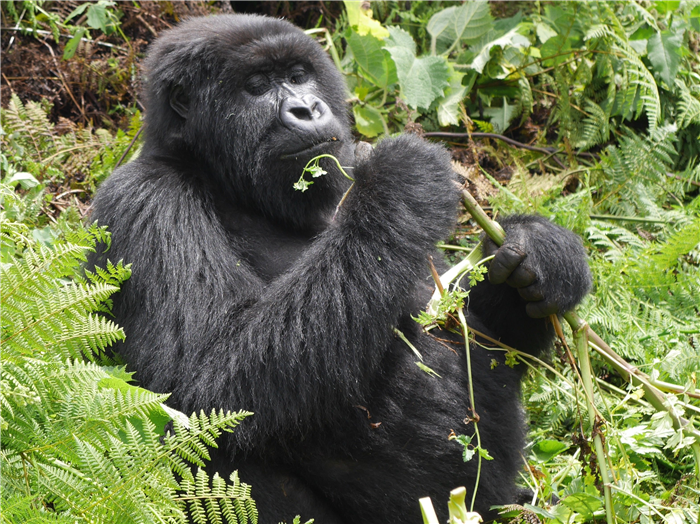
Research published in early 2016 showed that gorillas hum when contentedly when eating their favourite food.
“Gorillas seem to hum and sing when encountering food they really like,” explained Simone Pika of the Max Planck Institute for Ornithology, who led the study.
“This is very similar to our own behaviour when eating delicious food and emphasising this by also making ‘mmmmm’ sounds.”
How long does a gorilla live?
In the wild, a gorilla’s lifespan is around 35-40 years, but they often live longer in captivity, sometimes for over 50 years. The oldest gorilla ever recorded was a female western gorilla at the Columbus Zoo that reached the ripe old age of 60 before dying in 2017.
Gorillas build nests in which to sleep, both on the ground and in trees, made of leaves and branches. Counting abandoned nests is an effective way for scientists to estimate population size.
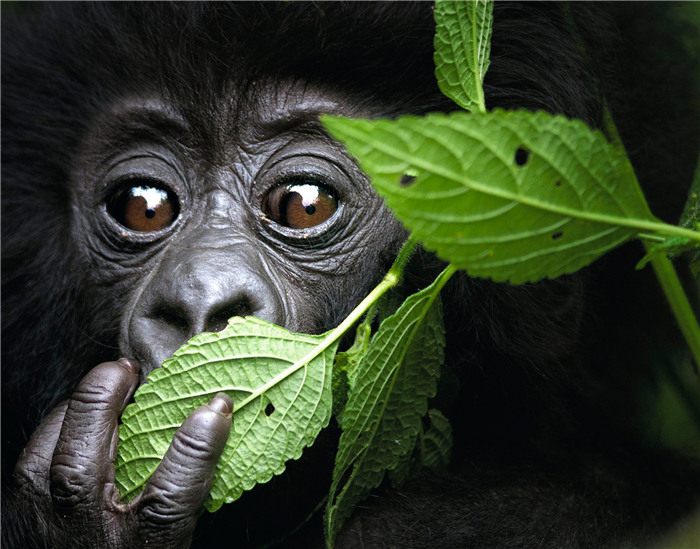
How can you tell individual gorillas apart?
Just like us, humans have unique fingerprints, but that’s not much use for identification in the field. More helpfully, gorillas also have unique noseprints, which can be used to identify individuals from photographs by looking at the nostrils and the bridge of the nose.
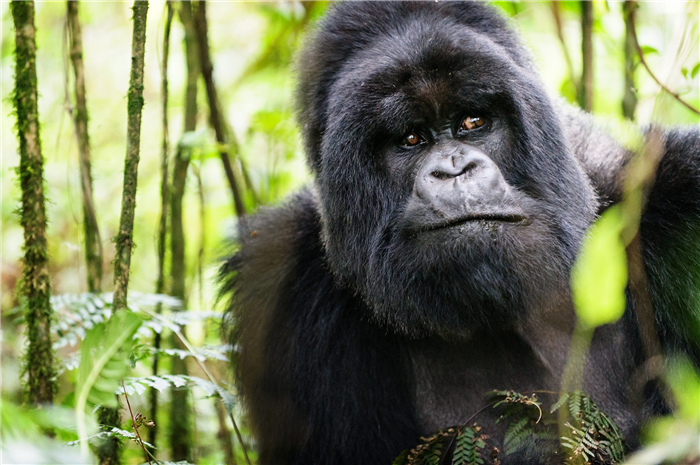
Gorillas can be identified by the shape of their noses. © Vicki Jauron/Babylon and Beyond Photography/Getty
How can gorillas knuckle-walk?
Gorillas (plus chimps and bonobos) are specialised knuckle-walkers. This is not because they can’t carry their weight upright – they can walk bipedally when necessary. As knuckle-walkers, gorillas have various adaptations for stability and weight-bearing.
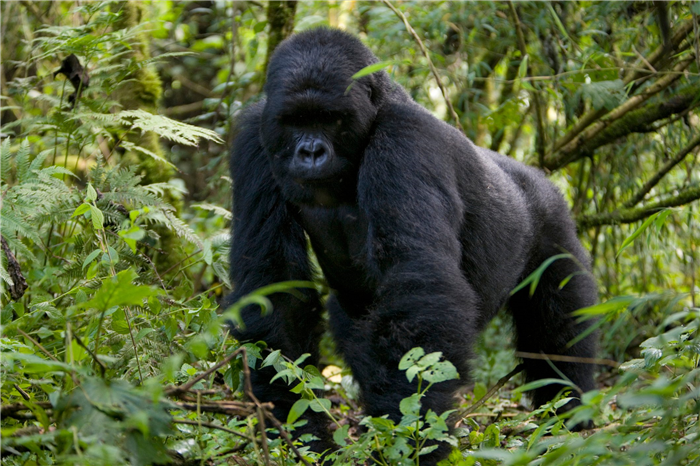
Silverback mountain gorilla knuckle-walking through the forest in Rwanda. © Thorsten Mils/robertharding/Getty
The middle and end phalanges (finger bones), which bear the animal’s weight, are widened and flattened for extra strength; in the forearm, the end of the radius that sits nearest the hand is both cupped and downward-facing, allowing it to fit snugly beside the scaphoid in the wrist; the metacarpals (knuckle bones) have ridges that ‘lock’ into place with the phalanges; and the skin on the fingers is thick as well as heavily padded.
All in all, a gorilla’s hands and wrists are strong, stable units capable of supporting a 270kg male.
How many babies do gorillas have?
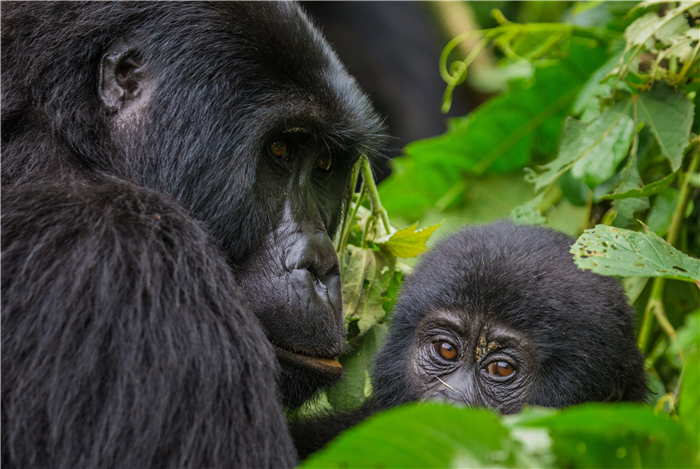
Female mountain gorilla with a baby in Bwindi Impenetrable Forest National Park, Uganda. © Andrey Gudkov/Getty
Females usually produce just one baby every four to six years. In total, a female will only give birth three or four times. Such a low reproduction rate makes it difficult for populations to bounce back following a decline.
A study in 2012 on captive populations revealed that female western lowland gorillas use a type of ‘baby talk’ to communicate with their babies. Scientists observed that mothers used more tactile and more repetitive gestures with their young than with other adults.
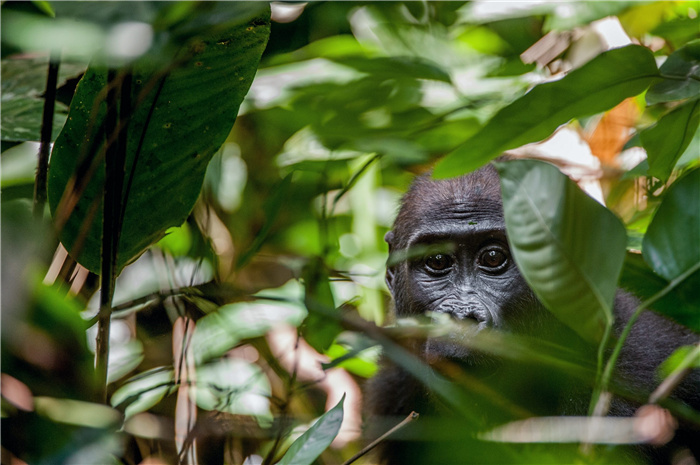
What is a baby gorilla called?
Baby gorillas are called infants, just like baby humans, which makes sense when we’re so closely related.
The history of the word ‘gorilla’ stretches back at least 2500 years. A Carthaginian explorer named Hanno the Navigator was on an expedition to the African west coast in around 500 BC when he came across a group of predominantly female primates that he described as savage, hairy women. We can’t be certain whether these were actually gorillas, some other kind of ape or even an unknown group of people, but Hanno’s interpreters told him they were called ‘gorillae’ and the name stuck.
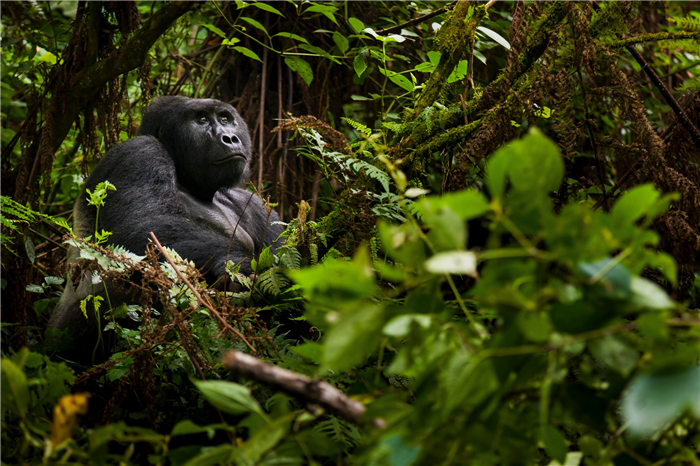
Is is true that gorillas help fight climate change?
Gorillas are the largest primates, with a huge appetite for leaves, shoots, stems, roots and fruit. An adult consumes 18–20kg of food daily, mainly foliage, and will swallow many large seeds intact. As gorilla families move through the forest to forage, they defecate, thereby depositing seeds far away from the parent trees.
Crucially, gorillas like to build sleeping nests in areas with an open canopy, and next morning tend to poop in the vicinity before heading off. This means that the dumped seeds are left sitting in piles of manure, under an uninterrupted sky – ideal conditions for germination.
So gorillas not only disperse trees but also encourage them to grow, thereby playing a key role in maintaining West and Central Africa’s tropical forests. In turn, this contributes to global carbon and water regulation, and helps to regulate our climate.
This Q&A originally appeared in BBC Wildlife Magazine, and was answered by Nikki Tagg.
Main image: A mountain gorilla silverback in Rwanda. © Panoramic Images/Getty
Final Thoughts
We hope that by now your questions about a gorilla’s diet are fully answered. We have to mention that while learning about gorillas is so much fun (and you should keep doing it), seeing them is a real treat.
If you can get a chance to see gorillas in the wild, you should definitely do it because looking into those red sad eyes is a humbling and comforting way to connect with nature.
We love to travel because of its potential to break barriers and its role in conserving natural ecosystems – like the habitats of gorillas. This is why it is easy to recommend travelling to these places. Plus, rich experiences are always worth the time and money.
